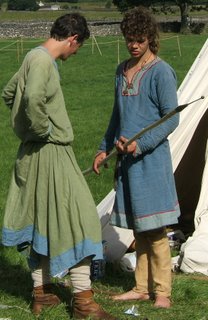 I spent the last weekend with the members of Regia Anglorum at Castleton helping to put on a show to the public at Peverel Castle, Castleton, Derbyshire, dateline 1080. I managed to grab a few snapshots before we opened to the public (taking photos whilst in kit is forbidden as it detracts from the authenticity...although I did sneak one of Lord William Peverel performing on his destrier!). To the left are a pair of squires preparing to limber up.
I spent the last weekend with the members of Regia Anglorum at Castleton helping to put on a show to the public at Peverel Castle, Castleton, Derbyshire, dateline 1080. I managed to grab a few snapshots before we opened to the public (taking photos whilst in kit is forbidden as it detracts from the authenticity...although I did sneak one of Lord William Peverel performing on his destrier!). To the left are a pair of squires preparing to limber up.It was a glorious day - near perfect weather and the Derbyshire Peaks, including Mam Tor surrounded us in a sheltering bowl. Around 1,200 people visited the site over the weekend.
I was on cooking pot duty on Sunday and chose to make a spicy beef stew. First fry onions and beef in a little fat in the cauldron over a brisk flame. Add plenty of chopped squished garlic. Then add quantities to your taste of cumin, ginger and black pepper. Give it a good stir, add stock or water to cover the ingredients, bring to boiling point, then raise cauldron from the fire to a height where the contents will softly simmer away for a couple of hours. Result, a meltingly tender stew with a superb, almost curry-like flavour. It's a recipe of my own adaptation, but based on existing recipes and a study of various household accounts and pipe rolls (albeit slightly later than 1080). We also dined on a luscious custard tart, courtesy of another Regia member. Sundries included bread and butter (churned on site) and a large bowl of blackberries.
There are several strands to why I find re-enactment so rewarding. There's the vast, multi-layered depth of knowledge posessed by fellow re-enactors, many of whom are historians or archaeologists in their own right. To be among fellow enthusiasts and talk for hours about one's favourite subjects without glazed looks or incomprehension is a joy beyond price. Then there's the thrill of seeing and handling objects and artefacts that are recreated to museum standard. Ah, so this is what it looked/felt like. This is how that object worked. I strongly feel it helps put the '3D' into my writing to have access to this aspect of re-enactment. To wear the clothes, walk the walk and be among others similarly dressed, gives me a sense of atmosphere. This is what it must have been like...or as near as I'm going to get in the 21st century!

2 comments:
Fascinating post, thank you. Experimental archaeology and re-enactment (closely related, it seems to me) add an extra dimension to history. Often it's only when you try to do something that you realise the picture in the textbook is completely wrong. I remember seeing a TV programme a while back about reconstructing an Iron Age chariot (I think it was the Wetwang burial, but it's roughly contemporary with Boudica). At first they tried building one with a rigid base, as per the drawings in all the academic textbooks, and found that as soon as they tried to drive it across a field at any speed it bucked and hopped and was nearly uncontrollable. It might, possibly, have worked on a smooth surface like an airport runway - not a lot of those about in the Iron Age (!). So then they tried building a wicker fighting platform suspended on rawhide cords, and found that was light, fast, stable and manoevrable. Eureka! So that's how it worked!
PS - the beef stew recipe sounds delicious. Would it have been for the elite only, given the spices in it?
Post a Comment